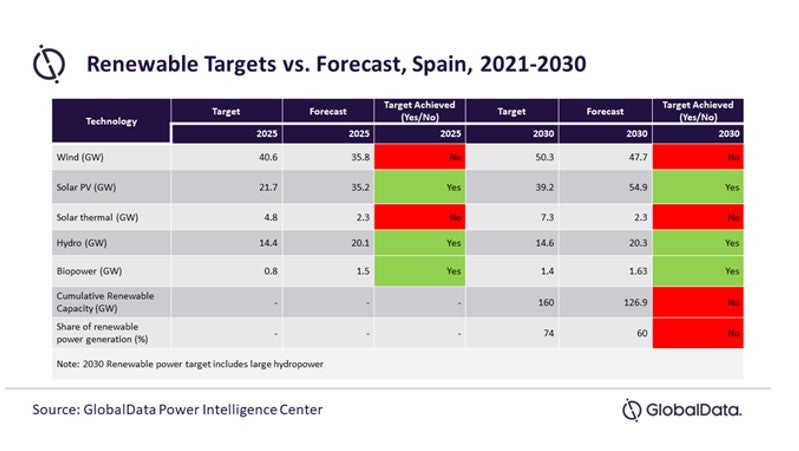GlobalData’s latest report, “Spain Power Market Outlook to 2035, Update 2022 – Market Trends, Regulations, and Competitive Landscape,” discusses the power market structure of Spain and provides historical and forecast numbers for capacity, generation and consumption up to 2035. Detailed analysis of the country’s power market regulatory structure, competitive landscape and a list of major power plants are provided. The report also gives a snapshot of the power sector in the country on broad parameters of macroeconomics, supply security, generation infrastructure, transmission and distribution infrastructure, electricity import and export scenario, degree of competition, regulatory scenario and future potential. An analysis of the deals in the country’s power sector is also included in the report.
The Spanish Government aims to achieve 160GW of total installed renewable capacity by 2030 and has set a target to achieve 74% renewable electricity generation by 2030 and 100% by 2050. The country has taken a meticulous approach towards phasing out coal power generation by 2025, decommissioning oil-power plants by 2030 and phasing out nuclear power completely by 2035.
All of this bode well for the renewables market as the government looks to fill the void with renewable power capacity. However, successive governmental change and poor implementation of effective usage of renewable power is a major challenge.
The government introduced auctions to lessen the economic burden caused by previously provided incentives such as Feed-in Tariffs (FiTs), but it slowed the growth of renewable power adoption. The government has estimated that investments of €241bn are required to meet the National Energy and Climate Plan 2021-2030 (NECP) targets, 80% of which is expected to come from the private sector.
Spain may fall short by nearly 23GW of its renewable capacity target and nearly 14% of its renewable generation target of 2030. The country needs to pull in private investments and improvise on effective use of technology to achieve optimum generation from its renewable power capacity.

In recent years, the Spanish Government has received too many proposals for renewable power projects with most likely to be rejected. However, the previous law meant they could not directly reject a project proposal without going through the entire administrative process.
To overcome this, the Spanish Government introduced simplified approval procedures under Spain’s Royal Decree-Law 6/2022. This meant that the ministry could fast-track projects that are most likely to see the light of day. The decree has also set provisions to conduct self-supply capacity auctions in nodes and has provided regulations for floating solar PV plants. These recent measures provide a positive boost that was desperately needed by the renewables market. Spain’s GDP (at constant prices) increased from $1,420.7bn in 2010 to $1,473.8bn in 2021, at a CAGR of 0.3%. The GDP (at constant prices) of the country declined sharply from $1,572bn in 2019 to $1,401.9bn in 2020 because of the Covid-19 pandemic. Backed by a stimulus package by the EU commission and several steps taken by the government, the GDP rose by 5.1% in 2021 from 2020.




